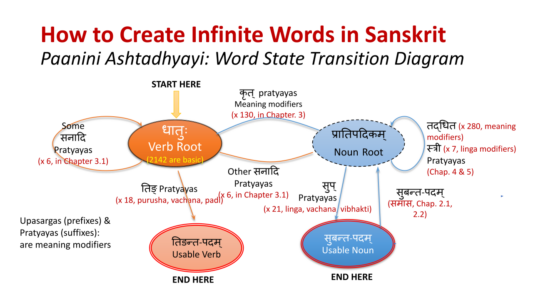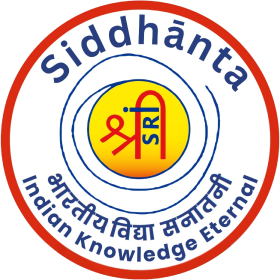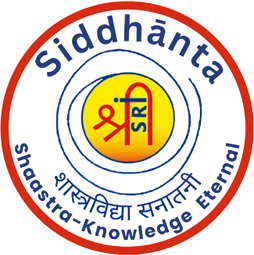Description
This course is an attempt to teach the rupa siddhi process of Ashtadhyayi by relying on the computational nature of Ashtadhyayi. This approach that we call the yantra-prakriyaa krama, will dramatically reduce the time and effort to understand Ashtadhyayi to a 3-credit course.
About the Course
Introduction
Vyakarana darshana is India’s science of language. It throws light on two aspects of language: sound (shabda) and sense (artha). It offers a scientific perspective on the nature of shabda, classification of shabda, the concept of vaakya and pada and the types of padas. It identifies certain common roots from which all possible padas can be derived. Different languages employ different conventions in pada formation, but the rules governing the classification and derivation of padas is common.This common framework has been elucidated in ashtadhyayi in the context of Sanskrit.
Sanskrit vyakarana needs to be studied in two dimensions:: shaabdika or word formation and aarthika or meaning or semantics. Though ashtadhyayi treatise covers both dimensions, majority of its study nowadays focuses on the shaabdika dimension. In this, there are two traditional methods of study:
- Prakriya krama, which studies how specific word forms and conjugations are achieved, by explaining sutras relevant to those forms, regardless where they are scattered in ashtadhyayi.
- Sutra krama (and its variant Paushpi krama), which studies ashtadhyayi sutras in the order they appear in the text, focussing on their role in word form generation.
In either case, how to understand various sutras is taught. The student is made to memorize as many sutras as possible so that when discovering how a word form is generated, the student can mentally recall which sutras apply in a given situation.
This method of studying ashtadhyayi relies heavily on memorization skills for effective understanding of ashtadhyayi process. It can be very tedious and time-consuming to master ashtadhyayi this way, and requires years of dedicated study, just to master the word formation process (rupa siddhi) of Sanskrit.

Ashtadhyayi as a Computational Engine
However, the advent of computing has opened up a much more rapid way of understanding the shaabdika dimension of Vyakarana and Ashtadhyayi.
The uniqueness of Ashadhyayi lies in its use of Sanskrit as a programming language. Ashtadhyayi sutras are composed using a stylized subset of Sanskrit that avoids the ambiguity of natural languages, and hence can be mechanically interpreted. Its sutras are sentences that describe a context, a condition and a consequence of matching them. Ashtadhyayi adopts a convention of using vibhaktis for sutra words as operators to describe the 3Cs. It minimizes the use of verbs. If one understands the mechanism of interpreting various types of sutras, and how the sutras come together to achieve word synthesis, then one can easily master the shaabdika aspect of ashtadhyayi rapidly.
Sarada Susarla’s PhD thesis [ref 1] under the guidance of Prof. Shivani V. (KSU) and Prof. Tilak Rao (Chanakya U.) has demonstrated that direct machine interpretation of Ashtadhyayi text corpus for rupa siddhi is indeed feasible, in the context of krdanta form generation. An open-source python interpreter called PAIAS [ref 2] has been developed to automate Ashtadhyayi’s word synthesis process via automatic selection and interpretation of the vast sutra corpus. Learning Ashtadhyayi using this tool helps a student get first-hand experience of Ashtadhyayi operation which is manually simulated in traditional methods. It helps avoid having to memorize ashtadhyayi in order to understand it. It liberates time for exploring higher semantic aspects of Vyakarana darshana where Bharat has made seminal contributions beyond the state of the art.
About This Course
This course attempts to teach the rupa siddhi process of Ashtadhyayi by relying on the computational nature of Ashtadhyayi. This approach, the yantra-prakriyaa krama, will dramatically reduce the time and effort to understand ashtadhyayi to a 3-credit course.
Course Objectives
- Gain first-hand appreciation of the systematic word synthesis model of the Sanskrit language.
- Understand the computational logic of Ashtadhyayi.
- Learn how to automate word form generation in Indic languages using the approach of Ashtadhyayi.
Expected Outcomes
- Gain the expertise necessary for Indic language processing.
About the Scholars
Course Designers: Prof. Tilak Rao, Chaitanya Lakkundi, Sarada Susarla, Sai Susarla
Instructors: Chaitanya Lakkundi, Prof. Tilak Rao
Syllabus
Detailed Syllabus
We estimate 3 sessions of 1.5 hours each per unit.
-
Unit 1: Components of Ashtadhyayi
- Sutras, paathas
- अष्टाध्याय्याः अङ्गानि
- धातुपाठः, गणपाठः
- वर्णाः, माहेश्वरसूत्राणि (Function for these)
- उपदेशः, शिक्षा (स्थानप्रयत्नविवेकः)
- Showcasing tool
- Upasarga, dhaatu and pratyayas
- Show how इत् works. Apply sutras.
- Modular operations
-
Unit 2: Purpose and Structure of various sutra types
- Samjna, paribhasha, vidhi
- Samjna sutras as macros and functions
- Paribhasha sutras as modifers of sutra text
- Vidhi sutras as rules: [context, condition] -> consequence
- Nimitta
- Concept of adhikaara and anuvriti
- Mahaavaakya of a sutra
- Role of Svaras in interpreting Ashtadhyayi.
-
Unit 3: Architecture of the Ashtadhyayi Word Synthesis Engine
- Conflict Resolution
- Paratva and Asiddhatva
- Utsarga and apavaada
- Order of sutra selection
- Ashtadhyayi’s unified approach to word synthesis of various types
-
Unit 4: Case study 1: Generation of subanta and taddhita forms
-
Unit 5: Case study 2: Generation of krdanta and tinanta forms
-
Unit 6: Case study 3: Generation of Samaasa forms and addition of upasargas.
Assignments
- Explore Ashtadhyayi sutras with the help of Software (using code)
- Add / Remove a sutra and see its difference to the rupa siddhi.
- Extend the software for taddhita. Add a taddhita sutra and debug to arrive at the final correct output.
- How to build new words using existing forms? Dhatu + pratyaya
- Understand the significance of इत् वर्णाः
- Add new paribhashas, and modify existing ones.
References
- Rule-based Computational Generation and Analysis of Kridanta Forms in Samskrit. Sarada Susarla, PhD Thesis, Karnataka Sanskrit University, Bengaluru. Feb 2024.
- PAIAS Ashtadhyayi Interpreter in Python available at https://gitlab.com/vedavaapi/apps/ashtadhyayi/
- Live web application on PAIAS: https://paias.sambhasha.ksu.ac.in/
- PAIAS: Panini Ashtadhyayi Interpreter as a Service (pdf). Sarada Susarla, Tilaka M. Rao, Sai Susarla. World Sanskrit Conference 2018, Vancouver, Canada.
- Machine-interpreting Pāṇini’s Aṣṭādhyāyī: A Feasibility Study with Kṛdanta Word Generation in Saṃskṛt (pdf). Sarada Susarla, Shivani V., Tilaka M. Rao, Sai Susarla, January 2022.
- https://ashtadhyayi.com/
Course and other details
Credits (L-T-P): 1-1-1 (Total 3 credits)
Hours per session: 1 hr 30 minutes (1hr for lecture and 30 minutes for discussion)
#sessions: 10-10-10 (Total 20 sessions and 10 weeks of practicals)
Target Audience: Science and Engineering students and Professionals
Prerequisites:
- Passed Samskrit Proficiency Test with a minimum score of 70%.
- Working knowledge of Samskrit Language and devanagari script.
- Optional: Working knowledge of computer programming. Python familiarity preferred.
Tentative Schedule:
- Start on July 24, 2024
- July, August: Every Wednesday, Saturday 7-8:30 PM IST
- September – November: Every Wednesday 7-8:30 PM IST
How to enroll:
Visit https://bharatiyavijnan.org/product/ashtadhyayi-as-software/




Reviews
There are no reviews yet.